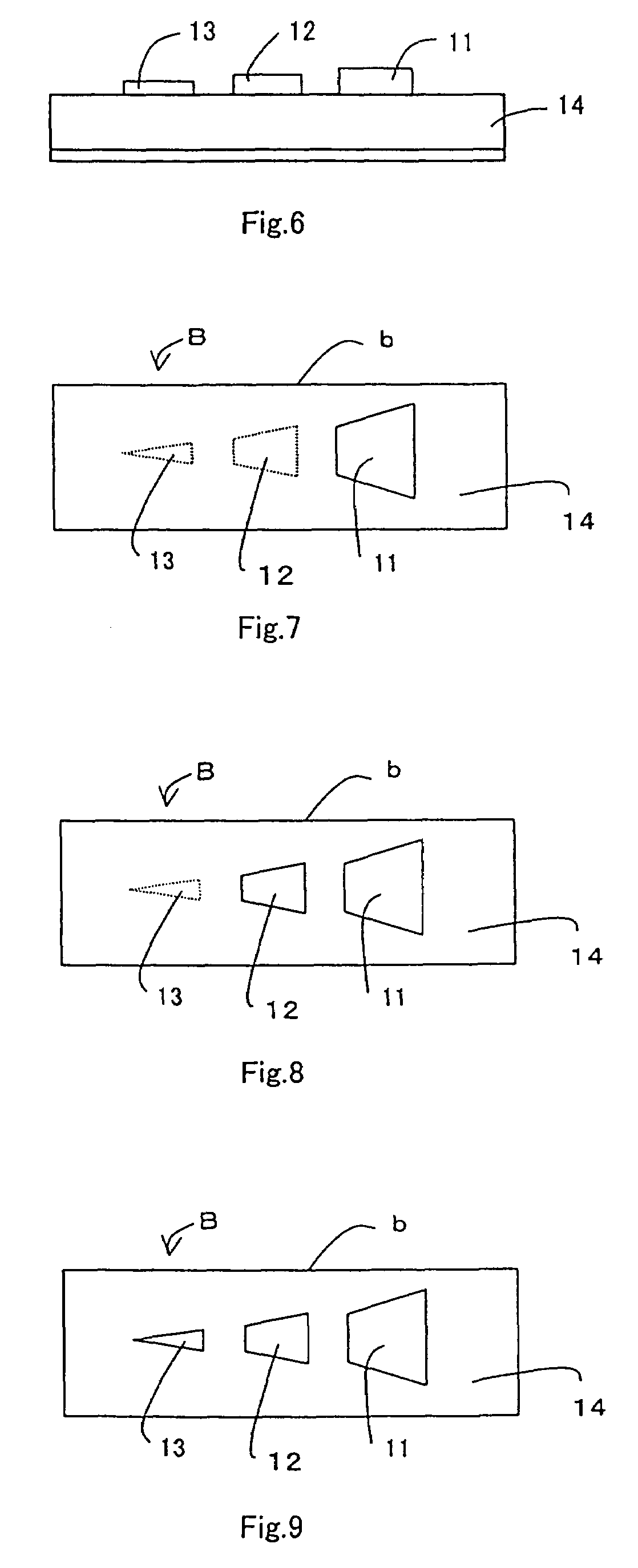Period indicator
a technology of period indicators and indicators, applied in the field of period indicators, can solve the problems of increasing costs, complicated production steps, and imposing limitations on the letters or marks to be used for display, and achieve the effect of improving display performan
- Summary
- Abstract
- Description
- Claims
- Application Information
AI Technical Summary
Benefits of technology
Problems solved by technology
Method used
Image
Examples
example 1
[0098]An indicative substrate “a” as shown in FIGS. 1 and 2 was prepared in the following manner.
[0099]A polypropylene film (covering 5) was overlaid on the surface of one side of a blue wet-laid nonwoven fabric, thereby forming a substrate 4. On the substrate 4, an indicative section containing three aligned, isosceles triangular regions 1, 2, and 3 was formed through screen printing by use of a material containing amorphous silica. The amounts of coating per unit surface area of the regions 1, 2, and 3 of the indicative section were adjusted to three different levels: 120 g / m2, 55 g / m2, and 35 g / m2, respectively. The regions of the indicative section differ in whiteness from one another due to a difference in masking performance caused by different amounts of coating. To the thus-formed indicative substrate “a,” oily liquid was incorporated, whereby a period indicator A was prepared.
[0100]The above materials and methods are described in more detail below.[0101]Substrate: Blue wet-...
example 2
[0107]An indicative substrate “b” as shown in FIG. 6 was prepared in the following manner.
[0108]Through use of a material similar to that employed in Example 1, an indicative section consisting of regions 11, 12, and 13 was formed on the substrate surface through screen printing. The three regions forming in combination an isosceles triangle were discretely disposed with spaces between the regions. The coating amounts of the indicative-section-forming material applied to the regions were different from one another. The area proportions of the regions 11, 12, and 13 of the indicative section were 4.7:2.9:1. The amounts of coating per unit surface area of the regions 11, 12, and 13 were 82 g / m2, 60 g / m2, and 24 g / m2, respectively. Similar to the case of Example 1, dimethyl phthalate was incorporated into the thus-formed indicative substrate “b”, whereby a period indicator B was prepared.
[0109]The above period indicator B was left to stand at room temperature (23° C.) under calm condit...
example 3
[0111]An indicative substrate “c” as shown in FIG. 10 was prepared in the following manner.
[0112]Through use of a material similar to that employed in Example 1, an indicative section consisting of regions 21, 22, and 23 was formed on the substrate surface through screen printing. The three regions forming in combination an isosceles triangle were disposed in contact with one another. The coating amounts of indicative-section-forming material applied to the regions were different from one another. The area proportions of the regions 21, 22, and 23 of the indicative section were 4.7:2.9:1. The amounts of coating per unit surface area of the regions 21, 22, and 23 were 68 g / m2, 35 g / m2, and 18 g / m2, respectively. Similar to the case of Example 1, dimethyl phthalate was incorporated into the thus-formed indicative substrate “c”, whereby a period indicator C was prepared.
[0113]In order to accelerate changes in development of a sign, the above period indicator C was left to stand under t...
PUM
| Property | Measurement | Unit |
|---|---|---|
| density | aaaaa | aaaaa |
| density | aaaaa | aaaaa |
| density | aaaaa | aaaaa |
Abstract
Description
Claims
Application Information
 Login to View More
Login to View More - R&D
- Intellectual Property
- Life Sciences
- Materials
- Tech Scout
- Unparalleled Data Quality
- Higher Quality Content
- 60% Fewer Hallucinations
Browse by: Latest US Patents, China's latest patents, Technical Efficacy Thesaurus, Application Domain, Technology Topic, Popular Technical Reports.
© 2025 PatSnap. All rights reserved.Legal|Privacy policy|Modern Slavery Act Transparency Statement|Sitemap|About US| Contact US: help@patsnap.com



